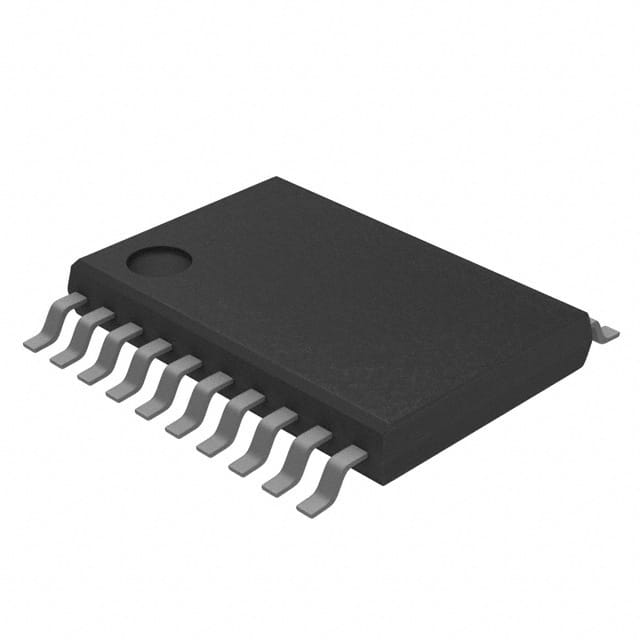SN74LVCH244APWR
Overview
- Category: Integrated Circuit (IC)
- Use: Buffer/Line Driver
- Characteristics: Low-Voltage CMOS Octal Buffer/Line Driver with 3-State Outputs
- Package: TSSOP (Thin Shrink Small Outline Package)
- Essence: This IC is designed to provide buffering and line driving capabilities for digital signals in low-voltage applications.
- Packaging/Quantity: Available in tape and reel packaging, with 2500 units per reel.
Specifications
- Supply Voltage Range: 1.65V to 3.6V
- Input Voltage Range: 0V to VCC
- Output Voltage Range: 0V to VCC
- Maximum Operating Frequency: 80MHz
- Number of Channels: 8
- Output Current: ±12mA
- Propagation Delay: 2.5ns (typical)
- Operating Temperature Range: -40°C to +85°C
Pin Configuration
The SN74LVCH244APWR has a total of 20 pins, which are assigned as follows:
- A1 - Input/Output
- Y1 - Output
- A2 - Input/Output
- Y2 - Output
- GND - Ground
- Y3 - Output
- A3 - Input/Output
- Y4 - Output
- A4 - Input/Output
- Y5 - Output
- A5 - Input/Output
- Y6 - Output
- A6 - Input/Output
- Y7 - Output
- A7 - Input/Output
- Y8 - Output
- VCC - Power Supply
- OE - Output Enable
- GND - Ground
- A8 - Input/Output
Functional Features
- Low-voltage operation allows compatibility with a wide range of digital systems.
- 3-state outputs provide flexibility in controlling the output signal.
- High-speed operation enables efficient data transmission.
- Schmitt-trigger inputs ensure robust signal reception and noise immunity.
- ESD protection guards against electrostatic discharge, enhancing reliability.
Advantages and Disadvantages
Advantages: - Wide supply voltage range allows for versatile use in various low-voltage applications. - 3-state outputs enable easy interfacing with other devices and bus systems. - High-speed operation ensures efficient signal propagation. - Schmitt-trigger inputs enhance noise immunity and signal integrity. - ESD protection enhances the IC's reliability in harsh environments.
Disadvantages: - Limited number of channels (8) may not be sufficient for certain applications requiring more I/O lines. - Propagation delay of 2.5ns may be relatively high for some high-speed applications.
Working Principles
The SN74LVCH244APWR operates by receiving digital input signals on its A1-A8 pins. These signals are then buffered and amplified to drive the corresponding Y1-Y8 output pins. The OE (Output Enable) pin controls the output state, allowing the user to enable or disable the outputs as needed. The IC operates within a specified supply voltage range and provides reliable buffering and line driving capabilities for low-voltage digital signals.
Detailed Application Field Plans
The SN74LVCH244APWR is commonly used in various applications, including:
- Microcontroller interfacing: It can be used to interface microcontrollers with external devices, such as sensors, displays, and memory modules.
- Communication systems: It is suitable for buffering and line driving digital signals in communication systems, such as UART, SPI, and I2C interfaces.
- Industrial automation: It finds application in industrial automation systems for signal conditioning and level shifting purposes.
- Automotive electronics: It can be used in automotive electronics for signal amplification and driving in low-voltage systems.
- Consumer electronics: It is suitable for use in consumer electronic devices, such as smartphones, tablets, and gaming consoles, for various signal buffering requirements.
Detailed and Complete Alternative Models
- SN74LVCH244A-Q1: Automotive-grade version of SN74LVCH244APWR, designed for extended temperature range and enhanced reliability in automotive applications.
- SN74LVC244A: Similar functionality to SN74LVCH244APWR but operates at a higher supply voltage range (1.65V to 5.5V).
- SN74LVC541A: Octal buffer/line driver with 3-state outputs, similar to SN74LVCH244APWR, but with inverted logic.
These alternative models offer similar functionality and can be considered based on specific application requirements.
Word count: 550 words
Senaraikan 10 soalan dan jawapan biasa yang berkaitan dengan aplikasi SN74LVCH244APWR dalam penyelesaian teknikal
Sure! Here are 10 common questions and answers related to the application of SN74LVCH244APWR:
Q: What is SN74LVCH244APWR? A: SN74LVCH244APWR is a type of integrated circuit (IC) that functions as an octal buffer/line driver with 3-state outputs.
Q: What is the operating voltage range for SN74LVCH244APWR? A: The operating voltage range for SN74LVCH244APWR is typically between 1.65V and 3.6V.
Q: What is the maximum output current of SN74LVCH244APWR? A: The maximum output current of SN74LVCH244APWR is typically around 32mA.
Q: Can SN74LVCH244APWR be used for bidirectional communication? A: No, SN74LVCH244APWR is a unidirectional buffer and cannot be used for bidirectional communication.
Q: How many input/output pins does SN74LVCH244APWR have? A: SN74LVCH244APWR has 8 input pins and 8 output pins.
Q: What is the purpose of the 3-state outputs in SN74LVCH244APWR? A: The 3-state outputs allow the IC to effectively disconnect from the bus, enabling multiple devices to share the same bus without interfering with each other.
Q: What is the typical propagation delay of SN74LVCH244APWR? A: The typical propagation delay of SN74LVCH244APWR is around 3.9ns.
Q: Can SN74LVCH244APWR tolerate overvoltage on its inputs? A: Yes, SN74LVCH244APWR has built-in protection diodes that allow it to tolerate overvoltage up to a certain limit.
Q: Can SN74LVCH244APWR be used in high-speed applications? A: Yes, SN74LVCH244APWR is designed for high-speed operation and can be used in various high-frequency applications.
Q: What is the package type of SN74LVCH244APWR? A: SN74LVCH244APWR is available in a TSSOP (Thin Shrink Small Outline Package) package with 20 pins.
Please note that the answers provided here are general and may vary depending on specific datasheet specifications or application requirements.


